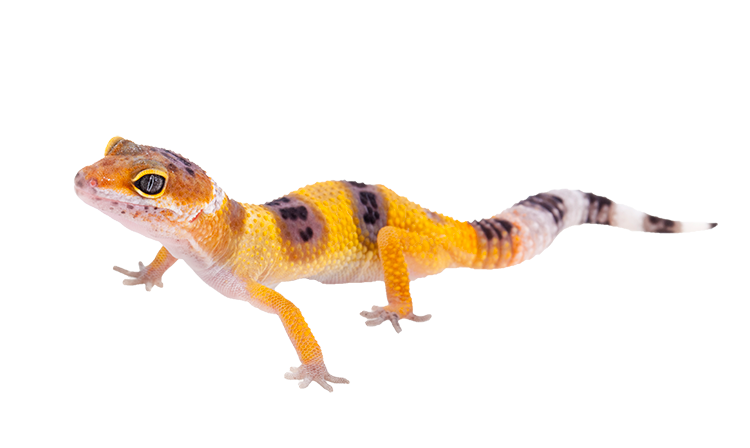Lizards, including bearded dragons, leopard geckos, and chameleons should be seen for a wellness exam at least once each year by a lizard veterinarian. Lizards require special care according to their species, and our team at Glenwood Pet Hospital is happy to help you provide the necessary daily care that your pet lizard needs for a lifetime of good health.

Bearded Dragon Care
Bearded dragons need a certain type of care to flourish in captivity. Our lizard veterinarian can assess your bearded dragon to ensure their health and provide recommendations for daily care as well. If you notice lethargy, inappetence, bloody stools, or any other symptom of illness in your dragon, please contact Glenwood Pet Hospital so we can examine your pet.
Basking Area for Heat
Bearded dragons need plenty of heat to thrive and regulate their body temperature based on the temperature of the environment they’re in. Provide a basking spot in your bearded dragon’s enclosure via a ceramic heat lamp with temperatures of 100-110°F. There should be a portion of the enclosure that maintains a temperature of 80-90°F as well. We recommend using a digital thermometer or infrared gun to gauge the temperature of your lizard’s enclosure.
Lighting for Vitamin C and Calcium Levels
Bearded dragons also require UVB light to stimulate and preserve vitamin C and calcium levels. A UVB light is readily available at most pet stores and should be placed between 12 and 18 inches above your dragon, or it will be ineffective. Placing it closer than 8 inches may result in injuries and is not recommended. The light will need to be changed every 6 months to maintain consistent UV rays for your dragon. We recommend creating a 12 hour light/dark schedule for your bearded dragon to abide by. Do not use glass below the UVB light as glass filters the UVB rays and it will be ineffective for your bearded dragon.
Enclosure
A 40-gallon aquarium with an easy to clean substrate is ideal for a bearded dragon. Avoid sand, mulch, bark, and gravel as these may lead to intestinal blockage if ingested. The enclosure needs to be at least 3 times the length of an adult bearded dragon and should include at least two hiding spots in different areas of the enclosure to ensure their comfort. A screen lid can be used to protect your lizard from accidental contact with the UVB light or heat lamp.
Appropriate Humidity
Humidity levels in your bearded dragon’s enclosure should be maintained at 30-40%. This can be done by spraying the enclosure with water several times daily or through an automatic mister. Provide a shallow dish for your dragon to soak in or drink out of and be sure to clean the dish regularly. Bearded dragons can benefit from 15-20 minute warm soaking baths to help with hydration.
Omnivore Diet
A healthy diet for bearded dragons should consist of plant and animal matter or insects, due to the lizard’s omnivorous nature. A salad with mixed greens (radicchio, arugula, dandelion, mint, watercress, endive, parsley) and vegetables (pumpkin, acorn squash, sweet potatoes and snap peas) should make up most of the dragon’s diet. One to two servings of protein should be provided as well as gut-loaded insects such as wax worms, meal worms, super worms, crickets and cockroaches. We also recommended dusting a calcium exclusive supplement onto your dragon’s salad or insects.
Leopard Gecko Care
In addition to regular wellness appointments, leopard geckos need consistent care that is best suited to their needs. Please let our team know if you notice any deviations of your pet’s appetite, weight, and behavior, as these may signal changes in their health as well.
Clean Enclosure
Optimal housing for a solitary gecko is a 20-to-30-gallon aquarium which would include:
- Small limbs for climbing
- Paper towel, artificial turf, or coconut fiber as a substrate
- A hide box complete with moist moss or coconut fiber for shedding
Be sure to clean your gecko’s enclosure every day to remove feces and spoiled or wet areas of substrate. The substrate should also regularly be completely changed or cleaned with a 5% diluted bleach solution. Fully rinse the enclosure with water and make sure it is completely air dried prior to returning your gecko to their home.
Short Duration Lighting
Leopard geckos can also benefit from 2-hour UVB exposures, taking place 12 hours apart to account for their crepuscular nature. This aids your lizard in generating vitamin D3 which allows for sufficient calcium absorption from the intestine. There is no need to supply your leopard gecko with vitamin D3 any other way, as an excess may have adverse effects. Place the UVB bulb at a safe distance from your gecko to avoid injury and make sure to change the bulb every 6 months to maintain efficacy. We recommend Exo Terra UVB 100, or click here for more information.
Varied Diet
Invertebrates such as dubia roaches, crickets, superworms, hornworms, and phoenix worms can help provide a variety in your gecko’s diet. We recommend providing a diet of Repashy Bug Burger and then gut loading these invertebrates with Repashy Superload 24-48 hours prior to feeding your leopard gecko. Invertebrates need to be dusted with calcium carbonate only 3-4 times a week to ensure proper nutrition for your gecko. Always keep a shallow water dish available as well. This should be changed daily to ensure you are providing your leopard gecko with fresh water.
Necessary Heat
Your leopard gecko’s enclosure should include a warm area of approximately 80-90°F during the day, dropping 5-10°F at night. We recommend using an under-tank heating pad or tape on one end of the enclosure rather than heat rocks which may burn your gecko.
Chameleon Care
We are here to address any questions or concerns regarding your chameleon’s appetite, weight, and behavior. Our chameleon veterinarian can offer recommendations specific to your pet chameleon.
Screened Enclosure
The best enclosure for a chameleon is a screened terrarium equipped with lots of artificial plants, logs, and branches for climbing and hiding. Offer water through a dripping system and maintain humidity at 65-80% using a misting system. This system is best used if it is set to go off every 1-2 hours for 5-15 minutes. This is your chameleon’s source of water as they rarely, if at all, drink from a bowl.
Lighting for Exposure
Chameleons require access to direct sunlight at least once a day or 4 times a week for an hour at a time. A UVB bulb, such as the Exoterra UVB 100, near the heat source is a great way to supply your chameleon with the necessary exposure. This bulb should be replaced every 6 months. For more on UVB exposure, click here. UVB bulbs should only be used as an alternative if direct sunlight is not possible. Exposure to UVB or direct sunlight helps your chameleon produce vitamin D3, which then stimulates needed calcium absorption from the intestine.
Heat for Chameleons
A basking area with a ceramic heat lamp at about 85-95°F during the day and dipping 10°F at night is also beneficial for chameleons. We suggest measuring the temperature using a thermometer or an infrared thermometer gun.
Invertebrate Diet
Variety is essential to a chameleon’s diet and should be provided invertebrates including dubia roaches, crickets, superworms, hornworms, and phoenix worms every other day. Invertebrates should be fed a nutritious diet before being gut-loaded with Repashy Superload. Dusting the invertebrates with calcium carbonate only 3-4 times per week is also necessary. This can help provide your chameleon with the most nutritious diet to maintain their well-being.


